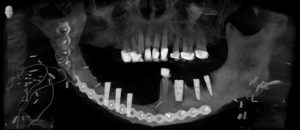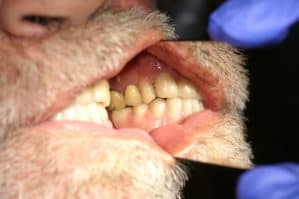Maxillofacial Reconstruction and Osseointegrated Dental Implant Prosthetics
Initial Contact
A 67-year-old male patient had been treated with radiation and chemotherapy 15 years previously for a squamous cell carcinoma at the base of his tongue. He presented at UAMS in October 2015 with swelling in his right jaw and was diagnosed with radiation-induced sarcoma. Mauricio Moreno, M.D., a head and neck surgeon in the Department of Otolaryngology – Head & Neck Surgery, resected the tumor and nearby tissue, including soft tissue, teeth and part of the jawbone. Moreno reconstructed the patient’s jaw at the time, using a metal frame and bone and skin grafts from the patient’s leg.
The reconstruction – though successful – did not restore the patient’s ability to eat solid food. Additionally, because of radiation at the site, the patient had developed osteoradionecrosis – bone death – which had damaged many of his remaining teeth.
The patient worked with Laurence J. Howe, D.D.S., a dentist and assistant professor in the UAMS Center for Oral Health and Dental Education, and John K. Jones, M.D., D.M.D., an oral and maxillofacial surgeon and assistant professor in the Department of Otolaryngology, to restore his teeth and ability to eat.
Assessment
With advancements in cancer treatments and surgical techniques, patients are increasingly surviving head and neck cancers, but they are often left with structural limitations that impact daily life. Teeth and portions of jawbone are often removed, and high-dose radiation damages remaining tissue and teeth.
These patients benefit from dental reconstruction, but traditional implants require deeper bone than is available with a typical bone graft. Adhesive dentures are often unusable for these patients because of dry mouth.
Dental implant prosthetics are an emerging solution and have high success rates in native bone and bone grafts and in both radiated and non-radiated bone.
Many of the procedures involved can be performed in the clinic, and some without sedation. Typically, patients need to wait at least three months after their tumor removal surgery before proceeding with a dental rebuild.
The patient was beyond that waiting period and opted for the implants.
Procedures

3D cone beam computed tomography was used to plan the diameter, length and position of the implants.
Jones’ role in the treatment of the patient was to manage his lockjaw and scar tissue, which prevented full range of motion and presented challenges for the procedures. Jones also prepared the soft tissue over the bone graft, because the skin was too thick. Jones thinned this tissue and the patient was allowed to heal for six months.
Howe removed the patient’s unrestorable teeth, leaving one on the bottom native jawbone to serve as a guidepost later during the creation of the dental implants and other dental pieces.
Jones inserted the metal screws into the bone graft, metal frame and native bone.
After about eight weeks of healing, Howe made impressions of the patient’s mouth, which he used for planning and sent to the dental lab, where the implant prostheses were created. He used wax and plastic bite rims to set up the correct positioning of the teeth, which was challenging because of the patient’s limited ability to open his mouth because of scar tissue.
Meanwhile, Howe worked to restore the patient’s upper jaw, including crowns on some remaining viable teeth and a removable partial denture. Once the top row of teeth was complete, the guidepost tooth on the bottom jaw was removed and the patient was allowed to heal for two or three weeks. An impression was made of the upper jaw to continue working on correct placement for the implant teeth on the bottom row.

The wax and plastic bite rims were used for the implant fittings, keeping the location of the pieces malleable until the final determination was made of their location. Everything was finalized after two fittings. The implants are held in place with a metal bar designed for plastic attachments.
Follow-up
The patient regained the ability to chew and eat solid food and reported a much-improved quality of life.
To make a referral to the Dental Clinic, call 501-526-7619. To make a referral to the Head & Neck Clinic, call 866-826-7362.
